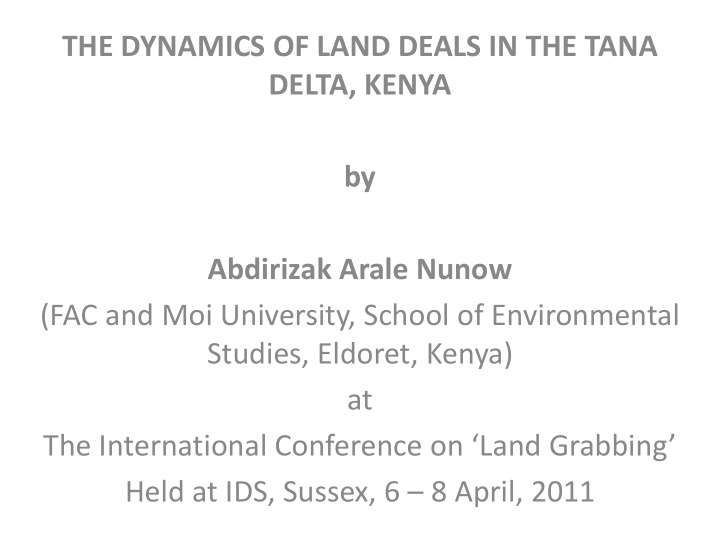



THE DYNAMICS OF LAND DEALS IN THE TANA DELTA, KENYA by Abdirizak Arale Nunow (FAC and Moi University, School of Environmental Studies, Eldoret, Kenya) at The International Conference on ‘Land Grabbing’ Held at IDS, Sussex, 6 – 8 April, 2011
Introduction to Tana River District • One of the seven (7) districts of coast province; • It has estimated population of 240,075 people; • The major communities include the Pokomo farmers who are Bantus and the Orma and Wardei pastoralists who are Cushitic; 2
Introduction Cont’d… • River Tana – a major source of water for people, livestock, wildlife and cultivation; • A large delta is formed between Mnazini and Kipini at the Indian Ocean; 3
Map Showing the location of Tana River District in Kenya 4
Introduction to Tana delta • The delta is one of the country’s largest and most important freshwater wetland ecosystems; • It supports pastoralists and small-scale subsistence farmers, all of whom have been dependent on the delta for many years; • Delta is also estimated to hold more than 50% of the national potential for irrigable land. 5
Land size and composition of the delta - Arable land = 3,822 (382,200 ha) - Water Mass = 3,226 Km 2 - Range land = 8,964 Km 2 Total Area = 16,012 Km 2 Tana river length in Km = 270 6
Importance of the Delta • Rich and diverse species of biodiversity; • Holds pasture reserves for critical periods; • Supports small-scale farmers and some agro- pastoralists; • Also supports minorities of hunter-gatherer communities, collectively known as the Wasanya or sometimes Watta. 7
Nature of ‘land grab’? • Usually (trans)national commercial land transactions – hence domestic as well as foreign; • Lease or purchase; • Main actors include: national government agencies, private investors and foreign governments – for crops , bio-fue l and/or minerals , for export. 8
The Kenyan Situation • There are 3 land tenure systems in Kenya: private, public and trust land; • New Constitution stipulates that all natural resources belong to the people and the government merely holds them in trust for them; • National Land Commission will be responsible for land and accountable to parliament; 9
• Vision 2030 considers foreign investment as key to agricultural development in the country; • About 60% of the population live in absolute poverty; • Lack of access to land is a major determinant of poverty in Kenya; • 80% of the land is ASALs, and only suitable for pastoralism, or partly for Irrigation; 10
Land in the Tana Delta • Land in the Delta is trust land and people don’t have titles to their ancestral lands; • Lack of titles makes the community/trust land vulnerable to land grabs; 11
Different land deals in the delta 1. TARDA-Mumias Partnership : 40,000 ha for monoculture sugar cane plantation – to provide sugar and Ethanol; • 25,000 people plus living in 30 villages have been/are being evicted by the project. Electric fencing of this land is now in progress. 2. Tiomin Kenya Ltd : For titanium mining; Deal underway, and exact size of land unclear so far; 12
3. Mat International: Acquiring 30,000 ha within the delta and another 90,000 ha from the adjacent districts - for sugar cane plantation; • Appears to have the support of the locals due to its planned out growers’ policy. 4. G4 Industries: Negotiating for 50,000 ha for oil seed farming. Negotiation at early stage. 5. Bedford Bio-fuels Inc: A multi-national acquiring 90,000 ha through 45-year lease for jatropha curcas. Negotiation with ranch owners. 13
6. Galole Horticulture Project: A private local co. acquired 5000 ha for horticulture – but now growing maize; 7. Emirate of Qatar: To lease 40,000 ha for 80 years to grow food for Qataris, in exchange for a US$ 3.5 billion loan to build a second deep water port for Kenya; - Shockingly, the government is transacting this deal when over 10 million Kenyans faced starvation after the 2009 and the 2011 droughts; 14
Impact of ‘land grab’ on the local delta communities • Restriction of access to key resources; • Pastoralists ‘grabbing’ their own grazing corridors as land protection mechanism; • Local elites taking ranches for themselves; • Displacement of local communities; 15
• Loss of dry season grazing pastures for pastoralists; • Loss of access to lands, water and fishing grounds to host communities. 16
Conclusion thus far … • Current ‘land rush’ aimed at getting done with before the new legal structures come into operation; • Pastoral lifestyle and the necessary mobility for sustainable livelihoods is in serious jeopardy; • The delta wetland may need International recognition for its effective protection under the Ramsar Convention; 17
• Trust lands allocations contrary to the provisions of the constitution should be revoked immediately, and reverted to their original owners/users; • Urgent need to quantify the economic and environmental values of the delta – to rationalize the need for its careful utilization. 18
THANK YOU FOR YOUR ATTENTION!! 19
Recommend
More recommend